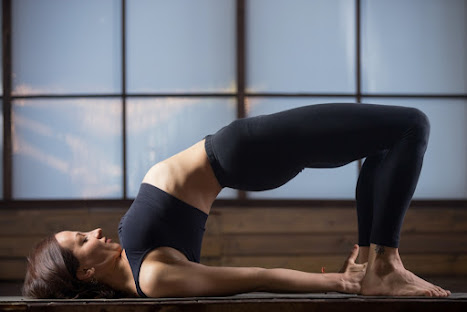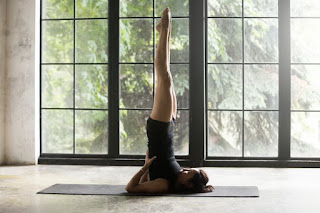Bridge Pose (Setubandha Sarvangasana) Variations and BenefitsElevate Your Yoga Practice
This versatile asana offers a wide range of advantages, from toning your muscles to calming your mind. In this article, we’ll take you through a step-by-step guide on how to perform the Bridge Pose correctly, and we’ll delve into the incredible benefits it brings to your body and mind.
Introduction to Bridge Pose (Setubandha Sarvangasana)
Bridge Pose, or Setubandha Sarvangasana in Sanskrit, is a yoga posture that resembles a bridge when fully executed. This asana primarily targets the spine, chest, and hips, making it an excellent choice for both beginners and experienced yogis, We can also say that this is a yoga pose for flexibility and strength.
It’s called “Setubandha Sarvangasana” because “Setu” means bridge, “Bandha” means lock, and “Sarvanga” means the entire body.
Preparatory Poses
Before attempting the Bridge Pose, it’s recommended to warm up with poses like:
- Sun Salutations (Surya Namaskar)
- Warrior Pose yoga (Virabhadrasana)
- Uttanasana (Standing Forward Fold)
- Child’s Pose (Balasana)
- Cat-Cow Stretch (Marjaryasana-Bitilasana)
- Downward-Facing Dog (Adho Mukha Svanasana)
Bridge Pose (Setubandha Sarvangasana) Step-by-Step Beginner’s Guide
Starting Position
- Begin by reclining on your back, bending your knees, and placing your feet at hip-width distance from each other.
- Keep your arms alongside your body, palms facing down.
Lifting Your Hips
- Inhale deeply, press your palms and feet firmly into the mat, and lift your hips off the ground.
- Roll your shoulders underneath you, interlocking your fingers to provide support.
Rolling Your Shoulders
- Lifting your hips and rolling your shoulders closer together creates space between your chin and chest.
- Engage your glutes and thighs to lift your hips higher while keeping your feet and arms grounded.
Holding the Pose
- Take deep breaths as you sustain the posture for a duration of 30 seconds to one minute.
- Focus on keeping your thighs parallel and your knees directly above your ankles.
- Maintain your focus ahead or softly close your eyes as you practice.
- Exploring Bridge Pose Variations
Variation 1: One-Legged Bridge Pose
Take your Bridge Pose to the next level by lifting one leg toward the ceiling while keeping the other foot firmly grounded. This variation challenges your core stability and strengthens the glutes while promoting balance and alignment.
Variation 2: Bridge Pose with Yoga Block
Placing a yoga block under your sacrum in the Bridge Pose provides additional support and elevation. This variation enhances the opening of the chest and shoulders and is particularly beneficial for individuals with limited spinal mobility.
Variation 3: Wheel Pose (Chakrasana) Bridge
Combine the benefits of Bridge Pose and Wheel Pose by transitioning from Bridge Pose to Chakrasana, also known as the Wheel Pose. This dynamic variation increases flexibility in the spine, strengthens the upper body, and stimulates the nervous system.
Variation 4: Supported Bridge Pose
Using props such as bolsters or blocks, create a restorative version of the Bridge Pose. This variation helps release tension in the back and hips, making it an excellent choice for relaxation and stress relief.
Variation 5: Shoulderstand Bridge
Integrate the benefits of Shoulderstand (Sarvangasana) into your Bridge Pose by lifting your legs overhead. This inversion variation improves blood circulation to the brain, relieves stress, and enhances thyroid function.
Variation 6: Bridge Pose with Leg Extension
Extend one leg straight out while maintaining the Bridge Pose position. This variation engages the hamstrings and strengthens the core muscles, contributing to better posture and stability.
Variation 7: Reclined Bound Angle Bridge
Combine the hip-opening benefits of Reclined Bound Angle Pose (Supta Baddha Konasana) with the Bridge Pose.
Place yoga blocks under the outer thighs to support the legs, allowing for a deeper stretch in the hips and groin.
Variation 8: Bridge Pose Twist
Incorporate a gentle twist into your Bridge Pose by bringing one knee across the body while maintaining the bridge shape.
This variation aids in spinal mobility and digestion while releasing tension in the lower back.
Also Read: Firefly Yoga Pose (Tittibhasana): Mastering Balance and Strength
Benefits of Bridge Pose and Its Variations
Strengthens the Back and Spine
Bridge Pose helps strengthen the muscles in your back, including the lower back, and improves spinal flexibility, which can alleviate discomfort and reduce the risk of injury.
Stretches the Chest and Neck
As you lift your chest towards your chin, Bridge Pose provides an excellent stretch for your chest and neck muscles, counteracting the effects of hunching over devices.
Stimulates Abdominal Organs
This asana encourages activity in the abdominal organs, supporting digestion and metabolic processes.. It also helps in detoxifying the body by improving blood circulation.
Relieves Stress and Anxiety
Bridge Pose offers a mild inversion, promoting relaxation and reducing stress. It calms the mind and provides relief from anxiety and mild depression.
Improves Digestion
By compressing the abdomen, Bridge Pose can help stimulate the digestive organs, aiding in better digestion and preventing constipation.
Tips for Practicing Bridge Pose Safely
Prior to trying any modified versions, ensure your body is adequately warmed up. Activate your core muscles to safeguard your lower back area. Employ props to provide support for your body, reducing the risk of strain. Pay attention to your body’s cues and refrain from pushing yourself excessively.
- Breathe deeply and consistently throughout the poses.
Incorporating Bridge Pose Variations into Your Yoga Routine for Specific Goals
Selecting the right variation depends on your experience level, flexibility, and fitness goals. Experiment with different variations to keep your practice fresh and challenging.
Yoga Sequence for Beginners
Include Bridge Pose in a sequence that starts with gentle warm-up poses and gradually builds up to more challenging asanas.
Advanced Yoga Flow
For experienced practitioners, use Bridge Pose as a transition between more advanced poses to create a seamless flow in your practice.
Enhancing Spinal Flexibility
Bridge Pose variations are particularly effective in improving spinal flexibility. Regular practice gradually releases tension and stiffness in the spine.
Strengthening Core Muscles
Many variations demand significant core engagement. Over time, this leads to stronger abdominal and oblique muscles.
Contraindications and Safety Precautions
When to Avoid Bridge Pose Variations
Individuals with neck or spine injuries, high blood pressure, or heart conditions should approach these variations cautiously or avoid them altogether. If you have any concerns, it’s important to seek advice from a medical professional.
Avoid Overarching the Back
While lifting the hips, avoid excessive arching of the back, which can strain the spine. Keep the movement smooth and controlled.
Use Props If Needed
If you’re a beginner or have any discomfort, place a block under your sacrum for support. Implementing thess Modifications can render the posture more approachable.
Listening to Your Body and Practicing Mindfully
Yoga is about self-awareness. Listen to your body’s cues and don’t push beyond your limits. Be mindful of how your body responds to each variation.
Conclusion: Elevate Your Practice with Bridge Pose Variations
Incorporating Bridge Pose variations into your yoga routine can transform your practice and provide a host of physical and mental benefits. By following proper alignment, breathing techniques, and mindfulness, you can explore the full potential of Setubandha Sarvangasana variations. Remember, every body is unique, so listen to your body’s signals and adjust the variations accordingly.
Also Read: Boat Pose Yoga (Naukasana): Benefits and How to do it
FAQs
Pregnant women should consult their doctor before practicing this pose, as it involves lifting the hips and may not be suitable for all trimesters.
2. Is Bridge Pose suitable for individuals with back pain?
Bridge Pose can be beneficial for individuals with mild back pain, but it’s important to practice with proper alignment and consult a professional if the pain is severe.
3. How long should I hold the pose?
Aim for holding Bridge Pose for about 30 seconds to a minute, focusing on steady breathing and alignment.
4. Can Bridge Pose help with insomnia?
Yes, Bridge Pose’s calming effects on the nervous system can aid in reducing insomnia. Practice it before bedtime for potential benefits.
5. What is the best time to practice this pose?
Bridge Pose can be practiced at any time of day. However, it’s often recommended as part of a morning or evening yoga routine to invigorate or relax the body respectively.
6. Are Bridge Pose variations suitable for beginners?
Absolutely! Some variations are accessible to beginners, but proper guidance is recommended.
7. Can Bridge Pose variations help with back pain?
Yes, certain variations can strengthen the back muscles and improve spinal flexibility, potentially alleviating back pain.
8. How often should I practice Bridge Pose variations?
Incorporate them into your yoga routine a few times a week, allowing your body time to recover.
9. Is it normal to feel discomfort during the poses?
Some discomfort is normal, but if you feel sharp pain, stop immediately and consult a professional.
10. What should I focus on while practicing these variations?
Focus on your breath, alignment, and how each variation makes you feel both physically and mentally.



